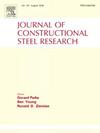Ultimate bearing capacity of X80 pipelines with incomplete penetration defects
IF 4
2区 工程技术
Q1 CONSTRUCTION & BUILDING TECHNOLOGY
引用次数: 0
Abstract
Incomplete penetration defects pose a significant threat to the safe operation of pipelines. Therefore, this study conducted numerical simulations to investigate the influence of incomplete penetration defects on the mechanical properties and ultimate load-bearing capacity of a 1422 mm diameter X80 pipeline, focusing on the strain distribution in defective pipelines and evaluating the ultimate capacity for pipelines with various defect characteristics. The results indicated that under internal pressure, the maximum strain occurred at the four corners of the defect, while the strain concentration shifted to the bottom of the defect when an additional bending moment was applied. Furthermore, it was found that the maximum strain increased with the depth and length of the defect, but decreased as the pipe wall thickness and defect width increased. Based on the three factors that had a more significant impact on pipeline strain—pipe diameter, defect depth, and defect width—a neural network model and a predictive equation were created to estimate the ultimate bearing capacity of pipelines with incomplete penetration defects. It has been verified that the predictions of both models exhibit a high degree of agreement with the simulation results, indicating that both models had provided accurate predictions for the pipeline's ultimate bearing capacity, which could be applied in experimental and practical engineering scenarios.
不完全侵彻缺陷X80管道极限承载力
不完全侵彻缺陷严重威胁着管道的安全运行。因此,本研究通过数值模拟研究了不完全贯通缺陷对直径1422 mm的X80管道力学性能和极限承载能力的影响,重点研究了缺陷管道中的应变分布,评估了不同缺陷特征管道的极限承载能力。结果表明:在内压作用下,最大应变发生在缺陷的四角处,当外加弯矩作用时,应变集中向缺陷底部移动;最大应变随缺陷深度和长度的增大而增大,随管壁厚度和缺陷宽度的增大而减小。基于对管道应变影响较大的三个因素——管径、缺陷深度和缺陷宽度,建立了不完全贯通缺陷管道极限承载力的神经网络模型和预测方程。验证了两种模型的预测结果与仿真结果具有较高的一致性,表明两种模型对管道极限承载力的预测是准确的,可以应用于实验和实际工程场景。
本文章由计算机程序翻译,如有差异,请以英文原文为准。
求助全文
约1分钟内获得全文
求助全文
来源期刊

Journal of Constructional Steel Research
工程技术-工程:土木
CiteScore
7.90
自引率
19.50%
发文量
550
审稿时长
46 days
期刊介绍:
The Journal of Constructional Steel Research provides an international forum for the presentation and discussion of the latest developments in structural steel research and their applications. It is aimed not only at researchers but also at those likely to be most affected by research results, i.e. designers and fabricators. Original papers of a high standard dealing with all aspects of steel research including theoretical and experimental research on elements, assemblages, connection and material properties are considered for publication.
 求助内容:
求助内容: 应助结果提醒方式:
应助结果提醒方式:


